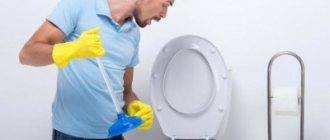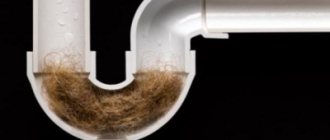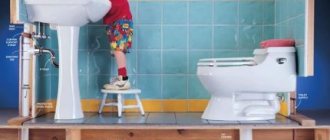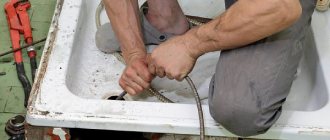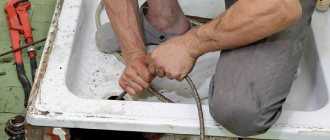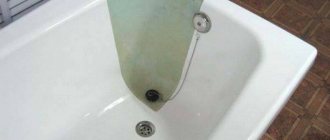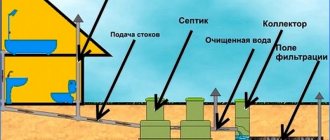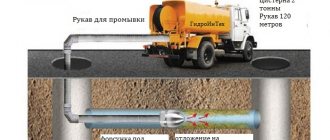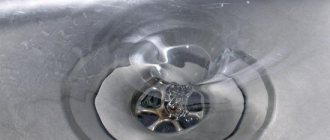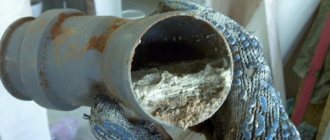In this article:
- 3 types of toilet clogs
- Advantages and disadvantages of cleaning a toilet with a cable
- Cable options for cleaning the toilet
- Instructions on how to clean a toilet with a cable
- Preventing toilet blockages
Folk remedies and household chemicals do not always help with blockages. In such cases, people begin to look for other ways, for example, cleaning the toilet with a cable. At first glance it may seem that this is an extremely simple procedure, but this impression is deceptive. There are three types of cables, plus they differ in diameter and type of attachments. Which one to choose?
In addition to purchasing the right tools, it is necessary to use a special cleaning technique so that the process itself does not take too much effort and time. In our article we will tell you which cable to choose, how to use it and what to do to prevent toilet blockages.
Causes of a clogged toilet
The narrowing of the pipes may be caused by hard water salts, deposits of which also cover the inner surface of the toilet, organic sediments and other substances thrown by people into the sewer system, as well as:
- Incorrect choice of toilet model or non-compliance of sewerage installation with technological requirements. An incorrect angle of inclination contributes to the growth of accumulations in the pipe.
- As a result of careless movement, a rag or cloth napkin may fall into the toilet, which will be washed away by the previously flushed water.
- Drained food scraps, fermented canned foods and homemade products.
- Cat litter, which is based on clay, thrown into the toilet.
- Building materials containing sand and cement.
- Large pieces of toilet paper.
Apartment owners remove clogs in the toilet using chemicals or mechanical methods.
Application of sewer cable
Design features
This widespread device allows you to effectively remove blockages in wastewater removal systems from an apartment or country house.
There are several types of product:
- wire;
- flexible shaft;
- steel tape.
A standard drain cleaning cable consists of a flexible steel core braided with some wire in the form of springs. The direction of the skeins alternates from layer to layer until the desired diameter of the device is achieved.
The material for the manufacture of the device is high-strength steel ST70, which can withstand rotation loads of up to 3500 rpm.
Photo of a plumbing cable
For ease of use, one end of the device is equipped with a handle with which the spring rotates, and on the other, special attachments can be installed to destroy the plug in the sewer system.
Pipe cleaning cable is sold at a regular hardware store. Its price is low, so it is advisable to purchase the product in advance, so that in the event of an emergency you are fully equipped.
Cable winding diagram for sewer cleaning
Making your own cable
You can make a tool for clearing sewer blockages with your own hands.
The instructions below will help you with this:
- The material for manufacturing will be an ordinary flexible steel cable of a suitable diameter.
- One end of it must be bent and slightly fluffed.
- Attach a ring or other device to the other end that allows you to rotate the cable while it is in the sewer system.
- It is recommended to place a piece of plastic pipe below the ring. You can use it to hold the cable while cleaning the drain.
To remove the blockage, you need to insert a homemade device into the sewer and, using rotational movements, slowly move it inward until the blockage is completely removed.
Homemade cable for dealing with blockages
Procedure for using a plumbing cable
Now let's look at how to clean pipes with a cable.
The work process is simple and consists of several sequential actions:
- A device with a nozzle installed on it is placed inside the drain system or in the opening of the toilet and moved to the point where the blockage has formed.
- To facilitate movement, it is necessary to make light rotational movements clockwise. This can be done using the handle.
- Once the plug has been removed and the permeability of the sewer system has been restored, the pipeline should be further cleaned using a plunger.
- The final stage is flushing the drain system with boiling water. This will help remove residual debris, disinfect the system and get rid of unpleasant odors from the pipes.
Scheme for using a cable to clean a toilet
Types of cable attachments
In order to effectively remove various types of blockages, certain attachments can be attached to the cable. Each of them is described in more detail in the table.
| Type of nozzle | Description |
| Donnaya | It is very good at removing plugs from the sewer system formed by sand, stone chips or bottom silt. |
| Punchy | Used to break the integrity and remove old, tightly packed plugs. |
| With hook | It is a hook that can be used to hook and remove clogs caused by hair, wool or textile fibers from the sewer system. |
| Loop | As the name implies, it is a loop made of high-strength galvanized spring steel. Allows you to effectively clean the interior of the toilet water seal. |
Plumbing cable attachments
How to pump out water
When the sewer is clogged tightly, the water drained from the tank does not flow into it. She overflows the cup. To clean the system, the liquid must be scooped out.
If the toilet is clogged, take an empty plastic bottle from any detergent or shampoo. Scoop out the contents as follows:
- a plastic container is placed in the toilet with the neck down and squeezed;
- lower the neck into the water and gradually release the pressure;
- when the liquid completely fills the bottle, place a bucket under it;
- squeeze until all the water flows out.
This simple method allows you to remove water not only from the toilet bowl, but even from the siphon.
Localization of the blockage
In order to clean the toilet yourself, you need to find the clog yourself. Watch how water flows from the bathtub or washbasin sink. If no failures are observed, then there is a blockage in the toilet siphon, the cuff that connects it to the sewer or outlet. Localization of blockage in a common pipe is expressed in the form of stagnation of water in the bath.
When there is a blockage in the riser, wastewater begins to gush out of the toilet. In this case, it is impossible to remove a clogged toilet with your own hands. Only professionals can cope with such a situation. It is urgent to call plumbers.
Time-tested benefits
The modern market is flooded with various means and devices designed to counteract blockages, but for many years the most effective and popular means for eliminating this nuisance has been and remains a plumbing cable.
To make a cable, strong iron wire twisted into a spiral is much more often used. Some products have a plastic braid, which significantly reduces the possibility of pipe damage during operation. In addition, the distinctive feature of the cables is their different lengths (from 1 to twenty meters or even 30 m) and thickness - from 6 to 13 mm. Diameter is a very important parameter that must be taken into account when choosing a tool, since the cable must move freely into the pipes.
The main advantages are low price and compactness (the optimal storage method is a rolled form). In addition, the plumbing cable is very easy to use, and the help of an expert is not required. It is possible to use the cable for any type of communications and the most complex blockages. Not only a plumber, but also most practical people will definitely have such a tool.
Mechanical cleaning
Mechanical cleaning is carried out if there are small children or pets in the house. But it is not possible to block their access to the work site. Mechanical methods of removing the plug allow you to immediately clear the blockage from the pipe. You won't have to wait long.
How to clean a toilet with a plunger
How can you break through a toilet at home? The plunger should always be located next to the toilet. It makes it quite easy to deal with traffic jams. You can clear a small clog in the toilet by following these steps:
- the rubber part of the plunger is immersed in water; if there is not enough water, it must be added;
- the drain hole must be completely closed;
- The plunger is rhythmically pressed inward, then returned to its original position.
A plunger gradually removes clogged particles and cleans the pipes.
How to clean and rinse the siphon
The siphon is a curved piece of pipeline that is located under the sink. The siphon often becomes clogged because hair, lint, pieces of food waste and other small debris accumulate in it. To remove accumulated debris, unscrew the elbow and remove the bent tube.
Clean and thoroughly rinse the siphon before reinstalling. Proven folk methods will help you clean your pipe.
Vinegar and soda
A solution of acetic acid and baking soda is used to clean sewer pipes from fatty deposits. Pour two hundred grams of baking soda into the drain hole, followed by two hundred milliliters of acetic acid.
Cover the drain hole with thick material. After twenty minutes, rinse the pipeline with boiling water. Using a solution of vinegar and salt can remove blockages in the siphon that have recently formed.
Lemon acid
Citric acid removes lime deposits from pipes. Pour one hundred grams of citric acid in the form of crystals into the siphon, then pour in two hundred and fifty milliliters of boiling water or acetic acid. Close the drain thoroughly and wait twenty minutes. Then flush the drain with boiling water.
Crystalline acid can be replaced with concentrated lemon juice in a volume of one hundred milliliters, which must be poured into the pipe for an hour.
Folk remedies
It happens that the toilet is clogged, and there are no special means and tools in the house to fix the problem. Or the homeowner does not want to use aggressive liquids. But there is no need to worry.
Some food products and ordinary detergents that are found in every kitchen will help you clean the toilet without a plunger or cable. It is necessary to use proven compounds to clear the resulting traffic jams.
Boiling water
This is one of the easiest ways. The clog can be washed out with boiling water. The liquid accumulated in the toilet bowl is drained. The bucket of boiling water is raised higher so that the stream flows into the toilet quickly and with pressure. If the blockage is cleared, the water level will begin to decrease.
For a better effect, pour boiling water over the toilet again. It is necessary to follow safety precautions, otherwise you may get burns. Plastic pipes should not be washed with boiling water. When exposed to high temperatures, they can become deformed or even burst.
Soda and vinegar
This is the most effective way to remove simple blockages. Cleaning the toilet with baking soda and vinegar is easy. But care should be taken when handling these substances.
The first method: mix half a pack of baking soda thoroughly and dissolve it in a bucket of hot water. The solution is then poured into the toilet. If you pour a bucket of hot water with soda quickly, the effect will be better. After some time, the blockage will resolve.
The second method: pour half a pack of soda into the toilet. Then a bottle of vinegar is poured there, the concentration of which should not exceed 9%. Close the drain hole for about two hours. After this, pour hot water into the bowl and wait about 30 minutes.
If no changes have occurred and the water does not drain freely, then the blockage is serious.
Alkali
Caustic soda or caustic soda is a strong alkali that cannot be diluted in an aluminum container. With its help you can get rid of blockages and deposits on the inner walls of sewer pipes:
- make a mixture of 5 liters of cold water and 2 kg of caustic soda;
- pour the resulting liquid into the toilet;
- the result is expected from 5 minutes to several hours, depending on the location of the blockage;
- pour a bucket of hot water.
When preparing the solution, wear work clothes that protect the body as much as possible.
Pepsi and cola
When clogged, Pepsi and cola help little. But if it is small, you can try. At night, pour a bottle of carbonated drink into the toilet and wait for the result. If there are no changes, you will still have to choose a more effective method.
Mustard
You can eliminate a sudden clog in the toilet with a solution of mustard in hot water. For 2 liters of water you need to take 1 teaspoon of mustard powder. And then:
- heat water in a 6 or 8 liter container;
- pour about 4 tablespoons of mustard into it and stir;
- pour it down the toilet and wait about half an hour.
After this, if the result was not achieved in order to get rid of the blockage in the toilet, everything is repeated.
General rules for caring for the device
The cable, like any other plumbing fixture, needs proper care. After each use, the instrument must be washed under pressure of water or in a filled container with the addition of a soap solution.
To avoid rust between the wire layers, the spring part of the tool must be regularly treated with machine oil.
In the future, if it is necessary to shorten the cable, the cut site will need to be pre-annealed by 10-12 cm.
Convenient rotation of the handle is ensured by the operation of special bushings; The task of a prudent owner is not to forget to periodically lubricate them with used engine oil
The oil-treated cable is wiped dry with a piece of cotton cloth and rolled into a coil. In this position, it takes up minimal space, making it easy to place it in a corner under the bathroom or in a cabinet among tools. With proper care, such equipment can serve its owner well for more than two decades.
All options for tools used in toilet cleaning are listed here. It is possible that they will help if you do not have a cable at your disposal, and you need to clear the jam urgently.
When do you need a plumber
If you cannot break through the toilet using available means, all methods and means of clearing blockages have not brought results, you need to think about calling specialists. They can inspect the plumbing and determine whether it is necessary to try to restore normal functioning or install new equipment.
This is especially true when the plumbing equipment is old, the drain hole in it is overgrown with a layer of urinary stone by about 15 mm. The plumber will quickly remove a massive dirt plug or remove the stuck object.
